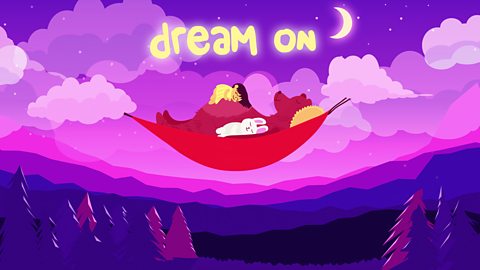Making music is the perfect rainy day or holiday break activity with family. Creating something with the people you care about is both an excellent way to relax and a way to learn something new about the people you're working with.
So why not hold a music jam with your family and discover how much fun performance can be?
A music jam is when a group of people work together to create a song (or songs) from scratch.
Listen to the audio in this article to hear how musicians Dame Evelyn Glennie and Omar Lye-Fook held their own music jam or read on for how you can have a go yourself.
When playing with your young musicians, let them get involved in every step of the process.
It's perfectly okay if things end up a little funky and off-beat.
1 - Decide the when and where of your Jam
A jam is as long as you want it to be.
Whether you want to work on a song over the school holidays or just make something on a rainy afternoon, the time that works for you is the right time for a jam.
Working somewhere you can be comfortable and relax is ideal.
Making music is a challenge, but we donãt want to make it stressful.
Dame Evelyn says: ãI'm a farmer's daughter, so I'm used to being outside a lotãÎ But yet most of my professional work is in cities or towns - busy places surrounded by people.
ãI've deliberately put myself in this quiet environment when I'm at home because for me whenever I see something move I imagine sound.
"It gives me inspiration - some balance in my life.
"Everything is musical - our whole landscape is like an orchestra.ã
Bring the Noise explore what goes into writing a song from scratch with musicians Dame Evelyn and Omar
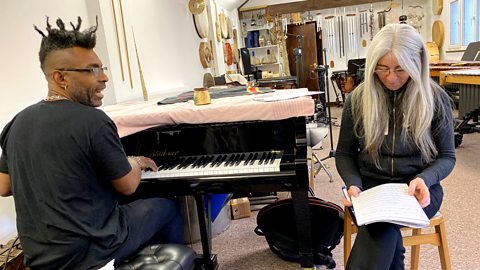
2 - Think of a theme
There's inspiration everywhere - does the noise of your neighbourhood remind you of a song?
Is there someone who you'd like to write a song for as a gift?
You can even look to the songs you already love for inspiration.
Omar says: ãI had an idea from something Evelyn had said about kids with hearing difficulties - in terms of their 'clock'.
"I started from the clock and started thinking of ãclockworkã and the tempo of the piece.
"Then we just explored what instruments we had that lend themselves to a clock theme or a dream theme or lullabies."
3 - Gather your instruments!
If you have musical instruments at home already, that's fantastic.
You might not have picked up a guitar or played the piano in a while but jams can be a great way to pick up the habit of playing again.
If you don't have any instruments to hand then don't despair, you can find interesting sounds and makeshift instruments around your house.
If you're stuck for ideas on what instruments you can make and find, our Found Sounds and Sonic Explorers video series have you covered.
And of course, your voice and body are incredible instruments too.
Humming, beatboxing, clapping and stamping can make a really unique sound.
Dame Evelyn says: ãI like things that are really normal but you don't imagine them to be instruments - for example, flower pots!
"When you strike a flower pot it's not particularly interesting but when you have a few of themãÎ
ãIf youngsters are not in a position where they have instruments or don't play instruments that shouldn't stop the creativity of sound-finding.ã

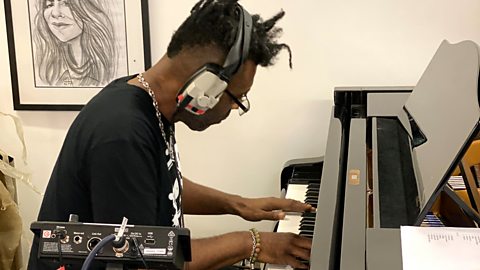
4 - Writing your song down
When you think of written music you might picture a musical stave and notes.
That's one way to write your musical ideas down, but don't worry if you can't read sheet music.
Have you heard of graphic notation?
It's a different way of recording music on paper, using shape and colour.
You might want to represent your drums as one shape and your shakers another.
The size of the shape might represent how loud or quiet the sound is and the colour represents whether itãs a high or low sound.
Everyone interprets graphic notation differently, choose rules that make sense to you.
Omar says: "I recorded my ideas on my phone. I'm quite used to doing that on the voice memo of my phone. Or just to film it - so you can see the notes [you're playing] and stuff.
"If you're good with writing notes - write it down. Hone your skills that way; it's another way of having a record of events."
Dame Evelyn says: "Even if you feel you can't write down notated music, you can write words.
"I'm more old fashioned I suppose with regards to not using my phone - I like to feel what it's like to write things down on a bit of paper."
5 - Song lyrics
Want to give your composition lyrics?
Some musicians start with words for their song already in mind and for others they like to work on the rhythm and melody of the song first.
Think back to the theme and inspirations you picked earlier.
Do they make you think of any key words?
If you write down lots of words about the theme, you can use them as the structure for your lyrics.
You can see this activity in practice in the Stories episode of Thunder Jam.
Omar says: "I've recently started writing music to lyrics - which I've never done before. I normally just have the melody and I'll write words to fit that.
"But it's a completely different animal if you've have the words already written there - because it inspires you in a different way.
"So I'm actually going to be trying to do that differently in the future.ã

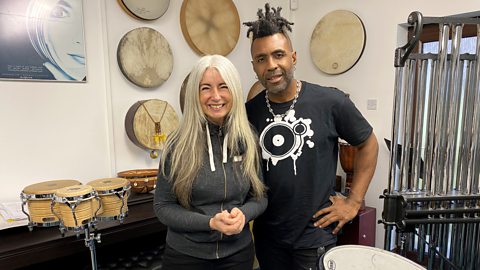
6 - Performing and recording
You've found your instruments, you've made a cool rhythm, and your lyrics are sounding great. Time to perform.
If you've not performed together before, it might take a bit of practice to match each other's rhythm.
On our website there are several activities you can play to get used to the rhythm of your band mates.
On top of that, there are many ways to get a digital metronome on your computer or mobile phone to help you keep time.
For young musicians a slower tempo (60-80 beats per minute) is easier to keep up with.
Sounding good? If you want to record your performance, there are plenty of ways to do it.
Recording a video on your mobile phone is fun and simple (though you might have to put your phone on a stand if you're one of the musicians!) but if you want to make sure your performance sounds clean and clear you can make a mini recording studio!
Some people think their singing sounds much better in the shower but the hard surfaces in your bathroom creates a lot of echo that doesn't sound so great recorded.
Your makeshift recording space should be small and have as many soft surfaces as possible to dampen any echo.
A blanket fort makes for a great space to record in - sing and play in luxury and comfort.
Omar says: "With my kids - my daughters - we have band practice together.
"One will sing and play the keyboard, the other sings and plays the drums, I'll get on the bass.
"And we'll just have a little work through of songs they quite like.
ãThat's the kind of thing that bonds us together.ã
7 - What next?
Congratulations on finishing your jam!
Even if what you made isn't going to be hitting the top of the Top 40 Singles Charts, be proud in that you've made something together.
Who knows, you might have discovered a hidden talent.
Omar says: "It's been a fantastic experience; I'd love to carry this further.
"In this day and age - people can sit in a studio by themselves and put a song together.
"But there's nothing quite like when you're working with other people. I would always encourage people to get together."
Dame Evelyn says: "Me too! It's been super.
"The sky's the limit [when talking about jamming together].
"You just literally have to do it! Give it a go - you'll lose absolutely nothing and gain everything."
Want to show us your rainy day performance? We'd love to see it! Tag @bbc_teach on Twitter or Instagram with the hashtag #musicjam. Happy performing!

More from Bring the Noise
Thunder Jam: This Is Me
Watch Omar teach body percussion and its endless possibilities.
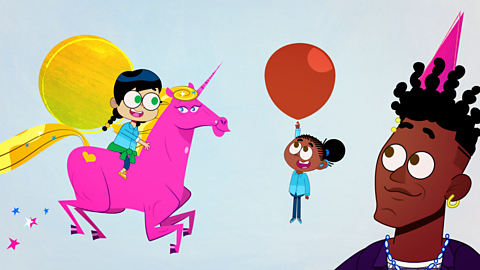
Thunder Jam: Rainforests
Lottie, Ben, Mia and the twins are transported to the tropical rainforest where they stumble upon Dame Evelyn Glennie.
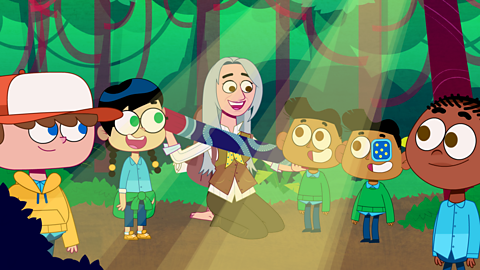
Dream On lyrics and lesson plans
Lyrics, lesson plan downloads and resources for use with Dream On.
